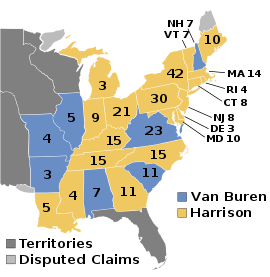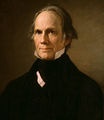Presidential election in the United States 1840
| ‹ 1836 • |
|||||||||||
| 14th presidential election | |||||||||||
| October 30 - December 2, 1840 | |||||||||||
|
|
|||||||||||
| Whig | |||||||||||
| William H. Harrison / John Tyler | |||||||||||
| electors | 234 | ||||||||||
| be right | 1,275,390 | ||||||||||
|
|
52.9% | ||||||||||
| Democratic Party | |||||||||||
| Martin Van Buren / Richard Johnson | |||||||||||
| electors | 60 | ||||||||||
| be right | 1,128,854 | ||||||||||
|
|
46.8% | ||||||||||
|
|
|||||||||||
| Election results by state | |||||||||||

|
|||||||||||
|
19 states
Harrison / Tyler |
7 states
Van Buren / Johnson |
||||||||||
|
|
|||||||||||
| President of the United States | |||||||||||
The US presidential election of 1840 took place between October 30 and December 2, 1840 , depending on the state . The Whig Party candidate, William Henry Harrison, was elected . In times of economic crisis he managed to beat incumbent President Martin Van Buren of the Democrats by a comfortable margin.
Candidates
Democratic Party
At the Democratic Party Conference in May 1840, President Martin Van Buren was nominated for a second term without opposition. However, Vice President Richard M. Johnson did not succeed in reasserting himself as Van Buren's running mate . Since no other applicant was able to bring the necessary number of delegates behind them, Van Buren ran without a vice-presidential candidate. It was the only time in American history that a candidate campaigned without a running mate. In the event of an election victory, the US Senate would have had to elect the vice president, as it did four years earlier , after not enough electors had voted for Johnson.
Whig party
Former Senator William Henry Harrison ( Ohio )
Senator Henry Clay ( Kentucky )
For the first time since the party was founded in 1833/34, the Whigs held a nomination convention. This took place in December 1839. In contrast to the election four years earlier, this time the party only wanted to put one candidate up for election and not several, which meant that they only wanted to get enough votes to prevent a democratic election victory. This strategy failed in 1836. The candidates were the influential Senator Henry Clay , who had run unsuccessfully for the presidency in 1828 and 1832, and the former Senator and General William Henry Harrison . After several ballots, Harrison secured the nomination, which was particularly favored by his fame as a war hero. The vice-presidential nominee was John Tyler of Virginia . This should primarily appeal to voters from the southern states .
Election campaign and result
Although the Democrats were unanimously behind Van Buren, the president was considered unpopular due to the aftermath of the economic crisis of 1837. The Whigs campaigned with the slogan "Tippecanoe and Tyler Too" . However, they avoided taking concrete positions on sensitive issues such as slavery or the establishment of a new national bank. Due to the economic conditions and the military fame Harrison could decide the choice with a clear lead. It was the first (of two) Whigs to win a presidential election. Harrison secured almost 53 percent of the vote, Van Buren was only able to unite 46.8 percent. In the Electoral College the result was even clearer: Harrison got 234 votes, Van Buren only 60. Van Buren was after John Adams and John Quincy Adams the third US president to be replaced after one term. Harrison took office on March 4, 1841.
This election is unique in that voters cast votes for four men who either were or would become president: President Martin Van Buren; presidential candidate William Henry Harrison; Vice-presidential candidate John Tyler , who would succeed Harrison in office after his death in April 1841; and James K. Polk , who got a vote in the Vice President election.
The turnout was 80.2% and thus more than 22 percentage points higher than in the presidential election in 1836 . Such a high increase in voter turnout has not occurred in presidential elections since then.
| candidate | Political party | be right | electors | |
|---|---|---|---|---|
| number | percent | |||
| William Henry Harrison | Whig | 1,275,390 | 52.9% | 234 |
| Martin Van Buren | democrat | 1,128,854 | 46.8% | 60 |
| James G. Birney | Liberty Party | 6,797 | 0.3% | 0 |
| total | 2,411,041 | 100% | 294 | |
particularities
William Henry Harrison became the first president to die in office (April 4, 1841) just 30 days after taking office. This makes his term of office the shortest of all presidents. It is said that after giving his two-hour swearing-in speech, the longest in presidential history, in cold weather, he contracted pneumonia and eventually died from it. Harrison was the oldest president at the age of 68 until Ronald Reagan's election victory in 1980 .
literature
- Richard Ellis: Old Tip vs. the Sly Fox: The 1840 Election and the Making of a Partisan Nation. University Press of Kansas, Lawrence 2020, ISBN 978-0-7006-2945-9 .
- Ronald G. Shafer: The Carnival Campaign: How the Rollicking 1840 Campaign of “Tippecanoe and Tyler Too” Changed Presidential Elections Forever. Chicago Review Press, Chicago 2016, ISBN 978-1-61373-540-4 .
- Donald Richard Deskins, Hanes Walton, Sherman C. Puckett: Presidential Elections, 1789-2008: County, State, and National Mapping of Election Data. University of Michigan, Ann Arbor 2010, ISBN 978-0-472-11697-3 , pp. 115-124 (= Chapter 16: Willian Henry Harrison's Election. ).
- Jan R. van Meter: Tippecanoe and Tyler Too: Famous Slogans and Catchphrases in American History. University of Chicago Press, Chicago 2009, ISBN 978-0-226-84969-0 , pp. 71-75 (= Tippecanoe and Tyler Too (1840) ).
- Gary May: John Tyler. Times Books, New York City 2008, ISBN 978-0-8050-8238-8 , pp. 48-60 (= 3. Tippecanoe and Tyler Too ).
- Robert Gray Gunderson: The log-cabin campaign . University of Kentucky, Lexington 1957, LCCN 57-011384
Web links
Remarks
- ^ Gail Collins : William Henry Harrison. (= The American Presidents Series. ). Times Books, New York City 2012, ISBN 978-0-8050-9118-2 , 113f.




